化学学报 ›› 2022, Vol. 80 ›› Issue (8): 1203-1216.DOI: 10.6023/A22030136 上一篇
综述
投稿日期:2022-03-29
发布日期:2022-09-01
通讯作者:
韩璐
作者简介: |
邓权政, 同济大学化学科学与工程学院2019级在读博士生, 本科毕业于同济大学, 现主要从事孔材料的电子显微学结构解析研究. |
 |
毛文婷, 2015年获得东华大学理学学士学位, 2021年获得上海交通大学(导师韩璐教授)理学博士学位. |
 |
韩璐, 同济大学化学科学与工程学院教授, 博士生导师. 2006年获上海交通大学理学学士学位, 2010年及2011年分别获得斯德哥尔摩大学及上海交通大学博士学位, 2011年入职上海交通大学, 2017年加入同济大学. 获2013年度全国优秀博士学位论文奖, 2014年度教育部自然科学奖一等奖(第二完成人), 2019年受自然科学基金优秀青年基金资助. 主要研究方向为介观结构材料的合成及电子显微学结构研究. |
基金资助:
Quanzheng Denga, Wenting Maob, Lu Hana( )
)
Received:2022-03-29
Published:2022-09-01
Contact:
Lu Han
Supported by:文章分享

孔径在介观尺度的多孔材料由于其规整的孔道结构、大比表面积、特殊的空间限域效应使其在吸附、分离、催化、传感、载药、能源等领域都具有广阔的应用前景. 深入解析材料的结构特征不仅是理解其物理化学性能和应用的关键, 也是研究材料的形成机理及新材料制备的重要反馈和支持. 电子显微学以电子为探针, 通过电子衍射和高分辨像对材料结构展开探索, 可以研究更小尺寸晶体的结构, 揭示局部结构信息如缺陷及共生等, 对介观尺度多孔材料的结构解析至关重要. 对近年来通过电子显微学方法解析的介观尺度多孔材料工作进行了综述, 主要针对有序介孔材料以及有序大孔材料展开, 归纳了不同结构类型的介观尺度多孔材料所适用的电子晶体学方法, 在此基础上提出电子显微学在介观尺度孔材料结构解析上的优势、不足和未来发展的方向, 以及将电子显微学用于其它材料结构解析的可行性.
邓权政, 毛文婷, 韩璐. 介观尺度多孔材料的电子显微学结构解析[J]. 化学学报, 2022, 80(8): 1203-1216.
Quanzheng Deng, Wenting Mao, Lu Han. Structural Solution of Porous Materials on the Mesostructural Scale by Electron Microscopy[J]. Acta Chimica Sinica, 2022, 80(8): 1203-1216.


































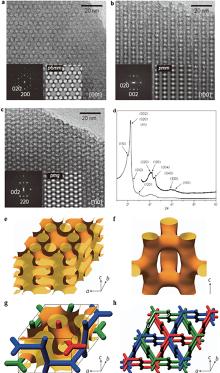

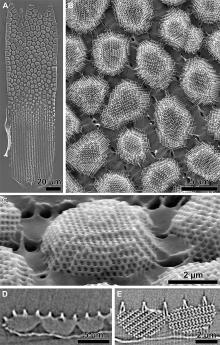

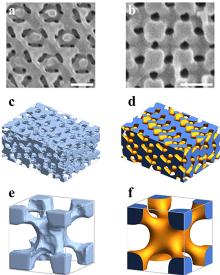

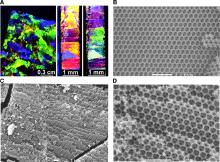

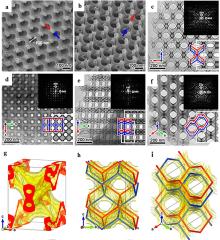

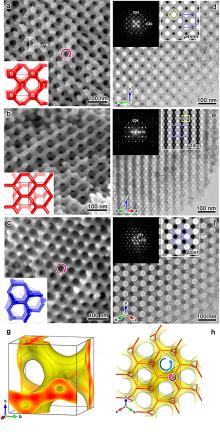



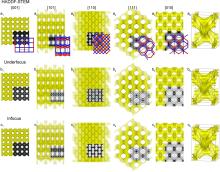

| [1] |
Kresge, C. T.; Leonowicz, M. E.; Roth, W. J.; Vartuli, J. C.; Beck, J. S. Nature 1992, 59, 710.
|
| [2] |
Huo, Q.; Margolese, D. I.; Ciesia, U.; Demuth, D. G.; Feng, P. Y.; Gier, T. E.; Sieger, P.; Firouzi, A. Chem. Mater. 1994, 6, 1176.
doi: 10.1021/cm00044a016 |
| [3] |
Wan, Y.; Zhao, D. Chem. Rev. 2007, 107, 2821.
doi: 10.1021/cr068020s |
| [4] |
Terasaki, O.; Liu, Z.; Ohsuna, T.; Shin, H. J.; Ryoo, R. Microsc. Microanal. 2002, 8, 35.
pmid: 12533202 |
| [5] |
Zhao, D.; Feng, J.; Huo, Q.; Melosh, N.; G. Fredrickson, H.; Chmelka, B. F.; Stucky, G. D. Science 1998, 279, 548.
pmid: 9438845 |
| [6] |
Inagaki, S.; Guan, S.; Ohsuna, T.; Terasaki, O. Nature 2002, 416, 304.
doi: 10.1038/416304a |
| [7] |
Che, S.; Liu, Z.; Ohsuna, T. Nature 2004, 429, 281.
doi: 10.1038/nature02529 |
| [8] |
Qiu, H.; Che, S. J. Phys. Chem. B 2008, 112, 10466.
doi: 10.1021/jp802615z |
| [9] |
Qiu, H.; Wang, S.; Zhang, W.; Sakamoto, K.; Terasaki, O.; Inoue, Y.; Che, S. J. Phys. Chem. C 2008, 112, 1871.
doi: 10.1021/jp709798q |
| [10] |
Zhao, D. Y.; Huo, Q. S.; Feng, J. L.; Chmelka, B. F.; Stucky, G. D. J. Am. Chem. Soc. 1998, 120, 6024.
doi: 10.1021/ja974025i |
| [11] |
Garcia-Bennett, A. E.; Che, S.; Tatsumi, T.; Terasaki, O. Chem. Mater. 2004, 16, 813.
|
| [12] |
Garcia-Bennett, A. E.; Kupferschmidt, N.; Sakamoto, Y.; Che, S.; Terasaki, O. Angew. Chem. Int. Ed. 2005, 44, 5317.
doi: 10.1002/anie.200500113 |
| [13] |
Xiao, C.; Fujita, N.; Miyasaka, K.; Sakamoto, Y.; Terasaki, O. Nature 2012, 487, 349.
doi: 10.1038/nature11230 |
| [14] |
Carlsson, A.; Kaneda, M.; Sakamoto, Y.; Terasaki, O.; Ryoo, R.; Joo, S. H. J. Electron. Microsc. 1999, 48, 795.
doi: 10.1093/oxfordjournals.jmicro.a023751 |
| [15] |
Gao, C.; Sakamoto, Y.; Sakamoto, K.; Terasaki, O.; Che, S. Angew. Chem. Int. Ed. 2006, 45, 4295.
doi: 10.1002/anie.200504114 |
| [16] |
Han, Y.; Zhang, D.; Chng, L.; Sun, J.; Zhao, L.; Zou, X. Nature Chem. 2009, 1, 123.
doi: 10.1038/nchem.166 |
| [17] |
Beck, J. S.; Vartuli, J. C.; Roth, W. J.; Leonowicz, M. E.; Kresge, C. T.; Schmitt, K. D.; Chu, C. T. W.; Olson, D. H.; Sheppard, E. W.; McCullen, S. B.; Higgins, J. B.; Schlenker, J. L. J. Am. Chem. Soc. 1992, 114, 10834.
doi: 10.1021/ja00053a020 |
| [18] |
Tüysüz, H.; Lehmann, C. W.; Bongard, H.; Tesche, B.; Schmidt, R.; Schüth, F. J. Am. Chem. Soc. 2008, 130, 11510.
doi: 10.1021/ja803362s pmid: 18671351 |
| [19] |
Kielman, T.; Asahina, S.; Schmitt, J.; Impéror-Clerc, M.; Terasaki, O.; Alfreason, V. Chem. Mater. 2013, 25, 4105.
doi: 10.1021/cm402635m |
| [20] |
Qiu, H.; Sakamoto, Y.; Terasaki, O.; Che, S. A. Adv. Mater. 2008, 20, 425.
doi: 10.1002/adma.200700809 |
| [21] |
Jin, C.; Han, L.; Che, S. Angew. Chem. Int. Ed. 2009, 48, 9268.
doi: 10.1002/anie.200904494 |
| [22] |
Aubert, T.; Ma, K.; Tan, K.; Winsner, U. Adv. Mater. 2020, 32, 1908362.
doi: 10.1002/adma.201908362 |
| [23] |
Xi, X.; Wu, D.; Han, L.; Yu, Y.; Su, Y.; Tang, W.; Liu, R. ACS Nano 2018, 12, 5436.
doi: 10.1021/acsnano.8b00576 |
| [24] |
Sakamoto, Y.; Kaneda, M.; Terasaki, O.; Zhao, D. Y.; Kim, J. M.; Stucky, G.; Shin, H. J.; Ryoo, R. Nature 2000, 408, 449.
doi: 10.1038/35044040 |
| [25] |
Huo, Q.; Margolese, D.; Ciesla, U.; Feng, P. Y.; Gier, T. E.; Sieger, P.; Leon, R.; Petroff, P. M.; Schüth, F.; Stucky, G. D. Nature 1994, 368, 317.
doi: 10.1038/368317a0 |
| [26] |
Zhao, D.; Feng, J.; Huo, Q.; Melosh, N.; Fredrickson, G. H.; Chmelka, B. F.; Stucky, G. D. Science 1998, 279, 548.
pmid: 9438845 |
| [27] |
Sakamoto, Y.; Díaz, I.; Terasaki, O.; Zhao, D. Y.; PérezPariente, J.; Kim, J.; Galen, D.; Stucky, G. D. J. Phys. Chem. B 2002, 106, 3118.
doi: 10.1021/jp014094q |
| [28] |
Miyasaka, K.; Han, L.; Che, S.; Terasaki, O.; Angew. Chem. Int. Ed. 2006, 45, 6516.
doi: 10.1002/anie.200601451 |
| [29] |
Han, L.; Sakamoto, Y.; Terasaki, O.; Li, Y.; Che, S. J. Mater. Chem. 2007, 17, 1216.
doi: 10.1039/b615209k |
| [30] |
Ma, Y.; Han, L.; Miyasaka, K.; Oleynikov, P.; Che, S.; Terasaki, O. Chem. Mater. 2013, 25, 2184.
doi: 10.1021/cm401294j |
| [31] |
Alfonso, E.; Garcia-Bennett, A. E.; Miyasaka, K.; Terasaki, O.; Che, S. Chem. Mater. 2004, 16, 3597.
doi: 10.1021/cm049398e |
| [32] |
Han, L.; Sakamoto, Y.; Che, S.; Terasaki, O. Chem.- Eur. J. 2009, 15, 2818.
doi: 10.1002/chem.200801688 |
| [33] |
Sakamoto, Y.; Terasaki, O. Solid State Sciences 2011, 13, 762.
doi: 10.1016/j.solidstatesciences.2010.04.006 |
| [34] |
Ohsuna, T.; Sakamoto, Y.; Terasaki, O.; Kuroda, K. Solid State Sci. 2011, 13, 736.
doi: 10.1016/j.solidstatesciences.2010.04.028 |
| [35] |
Sakamoto, Y.; Han, L.; Che, S.; Terasaki, O. Chem. Mater. 2009, 21, 223.
|
| [36] |
Che, S.; Lim, S.; Kaneda, M.; Yoshitake, H.; Terasaki, O.; Tatsumi, T. J. Am. Chem. Soc. 2002, 124, 13962.
doi: 10.1021/ja020854e |
| [37] |
Che, S.; Kamiya, S.; Terasaki, O.; Tatsumi, T. J. Am. Chem. Soc. 2001, 123, 12089.
pmid: 11724619 |
| [38] |
Han, L.; Xiong, P.; Bai, J.; Che, S. J. Am. Chem. Soc. 2011, 133, 6106.
doi: 10.1021/ja110443a pmid: 21469641 |
| [39] |
Sun, Y.; Ma, K.; Kao, T.; Spoth, K. A.; Sai, H.; Zhang, D.; Kourkoutis, L. F.; Elser, V.; Wiesner, U. Nat. Commun. 2017, 8, 252.
doi: 10.1038/s41467-017-00351-8 |
| [40] |
Wang, Y.; Deng, Q. Z.; Fujita, N.; Han, L. Chem. Mater. 2020, 32, 5236.
doi: 10.1021/acs.chemmater.0c01382 |
| [41] |
Kaneda, M.; Tsubakiyama, T.; Carlsson, A.; Sakamoto, Y.; Ohsuna, T.; Terasaki, O.; Joo, S. H.; Ryoo, R. J. Phys. Chem. B 2002, 106, 1256.
doi: 10.1021/jp0131875 |
| [42] |
Miyasaka, K.; Terasaki, O. Angew. Chem. Int. Ed. 2010, 49, 8867.
doi: 10.1002/anie.201003875 pmid: 20941719 |
| [43] |
Han, L.; Miyasaka, K.; Terasaki, O.; Che, S.; J. Am. Chem. Soc. 2011, 133, 11542.
|
| [44] |
Harold, M. P. MRS Bull. 1994, 19, 34.
doi: 10.1557/S088376940003949X |
| [45] |
Wu, M. X.; Fujiu, T.; Messing, G. L. Solids 1990, 121, 407.
|
| [46] |
Litovsky, E.; Shapiro, M.; Shavit, A. J. Am. Ceram. Soc. 1996, 79, 1366.
doi: 10.1111/j.1151-2916.1996.tb08598.x |
| [47] |
Zhang, Y.; Yu, S.; Lou, G. B.; Shen, Y. L.; Chen, H.; Shen, Z. H.; Zhao, S. Y.; Zhang, J. Z.; Chai, S. G.; Zou, Q. C. J. Mater. Sci. 2017, 52, 11201.
doi: 10.1007/s10853-017-0955-3 |
| [48] |
Wilts, B.; Zubiri, B.; Klatt, M.; Butz, B.; Fischer, M.; Kelly, S.; Spiecher, E.; Striner, U.; Schröder-turk, A. Sci. Adv. 2017, 3, e1603119.
doi: 10.1126/sciadv.1603119 |
| [49] |
Kobayashi, Y.; Yoshioka, S. J. R. Soc. Interface 2021, 18, 20210505.
doi: 10.1098/rsif.2021.0505 |
| [50] |
Velev, O. D.; Jede, T. A.; Lobo, R. F. Nature 1997, 389, 447.
|
| [51] |
Judith, E. G. J.; Wijnhoven; Willem, L. V. Science 1998, 281, 802.
pmid: 9694646 |
| [52] |
Zakhidov, A. A.; Baughman, R. H.; Iqbal, Z. Science 1998, 282, 897.
pmid: 9794752 |
| [53] |
Han, L.; Xu, D. P.; Liu, Y.; Ohsuna, T.; Yao, Y.; Jiang, C.; Mai, Y. Y.; Cao, Y. Y.; Duan, Y. Y.; Che, S. Chem. Mater. 2014, 26, 7020.
doi: 10.1021/cm5033139 |
| [54] |
Mao, W. T.; Cao, X.; Sheng, Q. Q.; Han, L.; Che, S. Angew. Chem., Int. Ed. 2017, 56, 10670.
doi: 10.1002/anie.201704639 |
| [55] |
Cao, X.; Xu, D.; Yao, Y.; Han, L.; Terasaki, O.; Che, S. Chem. Mater. 2016, 28, 3691.
doi: 10.1021/acs.chemmater.6b00308 |
| [56] |
Sheng, Q.; Chen, H.; Mao, W. T.; Cui, C. C.; Che, S.; Han, L. Angew. Chem. Int. Ed. 2021, 60, 15236.
doi: 10.1002/anie.202102056 |
| [57] |
Mao, W.; Bao, C.; Han, L. Microsc. Microanal. 2021, 27, 996.
doi: 10.1017/S1431927621012149 |
| [58] |
Yu, Y.; Liu, S.; Li, J.; Chen, Q. Y. Acta Phys.-Chim. Sin. 2009, 25, 1890. (in Chinese)
doi: 10.3866/PKU.WHXB20090914 |
|
(于勇, 刘世军, 李杰, 陈启元, 物理化学学报, 2009, 25, 1890.)
|
|
| [59] |
Wei, F.; Zhang, Q.; Wu, H.; Cao, C.; Song, W. Science China Chemistry 2017, 60, 1588.
doi: 10.1007/s11426-017-9148-6 |
| [60] |
Huang, M.; Yue, K.; Wang, J.; Hsu, C.; Wang, L.; Cheng, Z. Science China Chemistry 2018, 61, 33.
doi: 10.1007/s11426-017-9140-8 |
| [61] |
Su, Z.; Chen, Q.; Li, J.; Liu, S. Acta Phys.-Chim. Sinica 2007, 23, 1760. (in Chinese)
|
|
(苏兆辉, 陈启元, 李杰, 刘世军, 物理化学学报, 2007, 23, 1760.)
|
|
| [62] |
Sun, B.; Guo, Y.; Xu, L.; Huang, Z.; Wu, P.; Che, S. Acta Chim. Sinica 2012, 70, 2419.
doi: 10.6023/A12080533 |
| [63] |
Li, M.; Yu, J. Acta Chim. Sinica 2011, 69, 226. (in Chinese)
|
|
(李猛, 俞建长, 化学学报, 2011, 69, 226.)
|
|
| [64] |
Zhang, R.; Yang, C. Acta Chim. Sinica 2006, 64, 2165. (in Chinese)
|
|
(张蓉芳, 杨春, 化学学报, 2006, 64, 2165.)
|
|
| [65] |
Guo, B.; Wu, H.; Chen, J.; Wang, J.; Wei, H.; Mai, Y. CCS Chem. 2020, 2, 1410.
|
| [66] |
Xu, Z.; Li, L.; Chen, X.; Fang, C.; Xiao, G. CCS Chem. 2021, 3, 3514.
|
| [67] |
Sun, T.; Lei, W.; Ma, Y. H.; Zhang, Y. B. Chin. J. Chem. 2020, 38, 1153.
doi: 10.1002/cjoc.202000120 |
| [68] |
Jinschek, J. R.; Helveg, S. Micron 2012, 43, 1156.
doi: 10.1016/j.micron.2012.01.006 pmid: 22560892 |
| [69] |
Möebus, G.; Doole, R. C.; Inkson, B. J. Ultramicroscopy 2003, 96, 433.
doi: 10.1016/S0304-3991(03)00106-2 |
| [70] |
Zewail, A. H. Science 2010, 328, 187.
doi: 10.1126/science.1166135 pmid: 20378810 |
| [71] |
Pennycook, S.; Boatner, L. Nature 1988, 336, 567.
doi: 10.1038/336567a0 |
| [72] |
Stefan, W. Science 2007, 316, 1153.
pmid: 17525330 |
| [73] |
Cullis, A.; Canham, L. Nature 1991, 353, 335.
doi: 10.1038/353335a0 |
| [74] |
Midgley, P. A.; Weyland, M. Ultramicroscopy 2003, 96, 413.
pmid: 12871805 |
| [75] |
Peter, B.; Yang, D. S.; Zewail, A. H. Science 2007, 318, 788.
pmid: 17975063 |
| [1] | 杨宇洁, 巩宇锈, 顾天航, 张伟贤. 冷冻电子显微镜技术进展及环境研究应用★[J]. 化学学报, 2023, 81(8): 990-1001. |
| [2] | 卢岳, 葛杨, 隋曼龄. 白光及紫外光辐照下甲氨碘化铅基钙钛矿太阳能电池降解机制差异[J]. 化学学报, 2021, 79(3): 344-352. |
| [3] | 邵悦, 马勇. 氨基表面功能化的有序介孔杂合材料的一步法合成及其对重金属离子和CO2 的吸附特性[J]. 化学学报, 2012, 70(18): 1957-1962. |
| [4] | 王业红, 谭涓, 刘靖, 陈颖, 李旭影. 萃取法脱除介孔磷酸镍模板剂的研究[J]. 化学学报, 2010, 68(23): 2471-2476. |
| [5] | 朱瑾瑜, 沈逸, 吴龙, 甘思文, 陈安琪, 沈祝萍, 潘小庆, 陈勇. 有机/无机复合介孔膜的合成及其生物酶吸附行为研究[J]. 化学学报, 2010, 68(21): 2231-2237. |
| [6] | 宋琳, 朱大章, 孙晓宇, 汪世龙, 孙冬梅. 介孔球状纳米羟基磷灰石的多级组装合成[J]. 化学学报, 2009, 67(23): 2697-2702. |
| [7] | 袁金芳,李健生,顾娟,夏敏亚,孙秀云,韩卫清,王连军. 一种合成六方板状Zr-Ce-SBA-15介孔材料的新方法[J]. 化学学报, 2009, 67(11): 1271-1275. |
| [8] | 马秀芳,肖继军,黄辉,李金山,肖鹤鸣. HMX和HMX/HTPB PBX的晶体缺陷理论研究[J]. 化学学报, 2008, 66(8): 897-901. |
| [9] | 田博士,杨春. 温敏性介孔复合材料PNIPAAm/SBA-15的制备与表征[J]. 化学学报, 2008, 66(5): 505-510. |
| [10] | 曹洁明, 吴伟, 陈煜, 刘劲松, 曹喻霖, 何建平, 唐亚文, 杨春, 陆天虹. 新型阳极材料Pt-Ru/CMK-3的制备与性能研究[J]. 化学学报, 2007, 65(12): 1117-1122. |
| [11] | 张蝶青,万颖,李和兴. 喷雾干燥辅助表面活性剂自组装制备新型SiO2介孔材料[J]. 化学学报, 2006, 64(9): 894-898. |
| [12] | 张存满,刘茜,徐政. 具有碱催化活性的有序氮氧化硅MCM-41介孔分子筛的制备与性能研究[J]. 化学学报, 2006, 64(4): 313-319. |
| [13] | 廖菊芳, 邬泉周, 尹强, 王崇太, 李红玉, 李玉光. 磺酸功能化三维有序大孔材料的制备与催化性能研究[J]. 化学学报, 2006, 64(24): 2419-2424. |
| [14] | 麻明友. 胶体模板法制备有序大孔TiO2材料[J]. 化学学报, 2006, 64(13): 1389-1392. |
| [15] | 王振兴,丁士文,张美红,张玉卓. 自组装合成纳米复合TiO2-ZnO介孔材料及其光催化性能[J]. 化学学报, 2005, 63(3): 243-248. |
| 阅读次数 | ||||||
|
全文 |
|
|||||
|
摘要 |
|
|||||